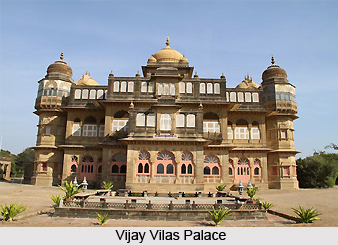 Vijay Vilas Palace was constructed by architects and craftsmen from Jaipur. Vijaya Vilas Palace is the celebrated summer palace of Jadeja Rajas of Kutch and is situated on the sea-beach of Mandvi in Kutch. The palace is located on the banks of Rukmavati River and it is almost 8 kms away from Mandvi.
Vijay Vilas Palace was constructed by architects and craftsmen from Jaipur. Vijaya Vilas Palace is the celebrated summer palace of Jadeja Rajas of Kutch and is situated on the sea-beach of Mandvi in Kutch. The palace is located on the banks of Rukmavati River and it is almost 8 kms away from Mandvi.
Architecture and location of Vijay Vilas Palace
The magnificent palace is built in an Indo-European style with wonderful stonework with the red brickwork in the Rajput chic, with a main central arena, bastions at the corner and with the colored glass windows. A superb view of the contiguous area and the king`s tomb can also be seen from the balcony at the top. The palace is 7 km from the center of town which is open every day from 9am-1pm and 3pm-6pm for the tourists and visitors. The Vijay Vilas Palace was erected with the idea of being functional as the country retreat. While keeping in mind this plan, the rulers built the palace on the hills with great views of the Shatrunjaya hill and historic Palitana temples.
Attractions of Vijay Vilas Palace
A unique attraction of the palace is the privately-owned beach. The former princely family now offers housing in a tented resort at the beach site. The resort has been designed to look like a majestic guest camp keeping with the position in the palace parkland, with each tented room featuring British royalty style wooden furniture, modern bathrooms and a courtyard. The open-sided restaurant on the beachside has a never-ending sea sight and barbecues are arranged on the beach and the other beach amenities include a volleyball court, deck chairs and shady sitting collections.



















